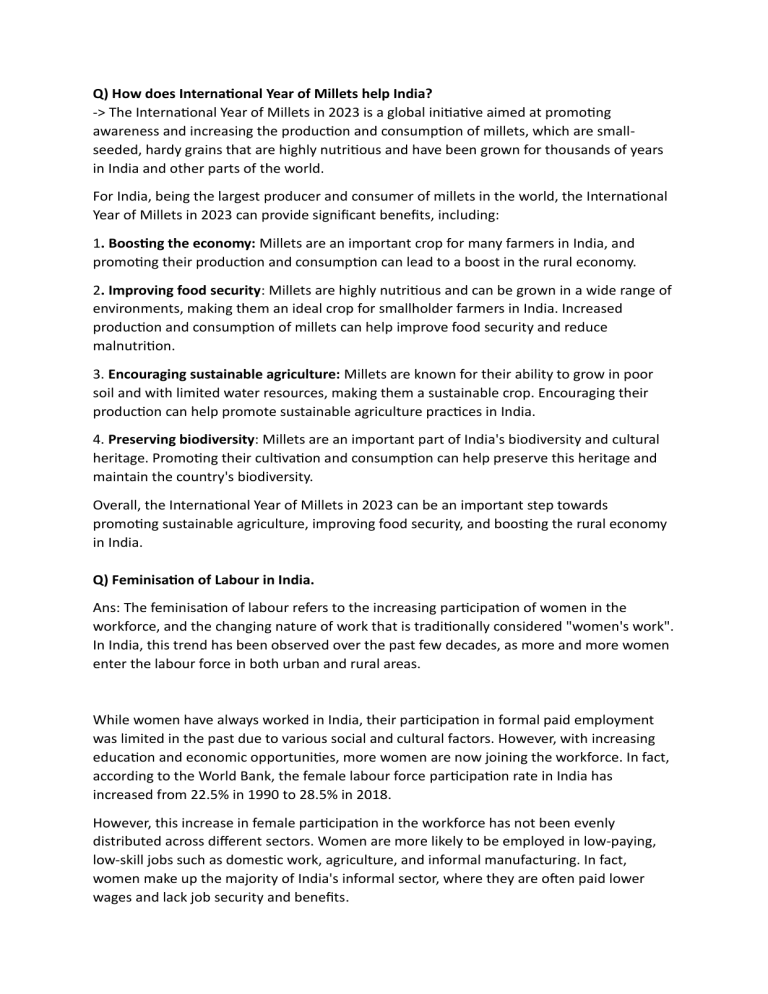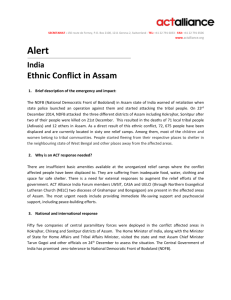
Q) How does International Year of Millets help India? -> The International Year of Millets in 2023 is a global initiative aimed at promoting awareness and increasing the production and consumption of millets, which are smallseeded, hardy grains that are highly nutritious and have been grown for thousands of years in India and other parts of the world. For India, being the largest producer and consumer of millets in the world, the International Year of Millets in 2023 can provide significant benefits, including: 1. Boosting the economy: Millets are an important crop for many farmers in India, and promoting their production and consumption can lead to a boost in the rural economy. 2. Improving food security: Millets are highly nutritious and can be grown in a wide range of environments, making them an ideal crop for smallholder farmers in India. Increased production and consumption of millets can help improve food security and reduce malnutrition. 3. Encouraging sustainable agriculture: Millets are known for their ability to grow in poor soil and with limited water resources, making them a sustainable crop. Encouraging their production can help promote sustainable agriculture practices in India. 4. Preserving biodiversity: Millets are an important part of India's biodiversity and cultural heritage. Promoting their cultivation and consumption can help preserve this heritage and maintain the country's biodiversity. Overall, the International Year of Millets in 2023 can be an important step towards promoting sustainable agriculture, improving food security, and boosting the rural economy in India. Q) Feminisation of Labour in India. Ans: The feminisation of labour refers to the increasing participation of women in the workforce, and the changing nature of work that is traditionally considered "women's work". In India, this trend has been observed over the past few decades, as more and more women enter the labour force in both urban and rural areas. While women have always worked in India, their participation in formal paid employment was limited in the past due to various social and cultural factors. However, with increasing education and economic opportunities, more women are now joining the workforce. In fact, according to the World Bank, the female labour force participation rate in India has increased from 22.5% in 1990 to 28.5% in 2018. However, this increase in female participation in the workforce has not been evenly distributed across different sectors. Women are more likely to be employed in low-paying, low-skill jobs such as domestic work, agriculture, and informal manufacturing. In fact, women make up the majority of India's informal sector, where they are often paid lower wages and lack job security and benefits. The feminisation of labour has also led to a shift in gender roles and expectations within households. As more women become breadwinners, they are challenging traditional gender norms and taking on roles traditionally reserved for men. This has the potential to improve gender equality and empower women in both the workplace and their personal lives. However, there are also challenges associated with the feminisation of labour in India. Women often face discrimination in the workplace, including unequal pay, harassment, and limited opportunities for advancement. They also face challenges in balancing work and family responsibilities, which can limit their ability to participate fully in the workforce. In conclusion, while the feminisation of labour in India has the potential to empower women and improve gender equality, there is still a long way to go to ensure that women have access to equal opportunities and fair treatment in the workplace. Q) Economic impact of partition of India on Assam. Ans: The partition of India in 1947 had a significant economic impact on Assam, a northeastern state that was then part of British India. The partition resulted in the division of the region into two separate countries, India and Pakistan, and created a new international border that cut through Assam, separating it from East Pakistan (now Bangladesh). One of the main economic impacts of the partition was the disruption of trade and commerce between Assam and East Pakistan. Prior to partition, Assam had a thriving trade relationship with East Pakistan, which was a major market for Assamese tea, jute, and other agricultural products. However, after partition, trade between the two regions was severely curtailed, as the new border made it difficult and expensive to transport goods across the border. This had a negative impact on Assam's economy, as many of its farmers and traders lost access to a key market for their goods. The partition also led to an influx of refugees into Assam from East Pakistan, as millions of Hindus and Sikhs fled the violence and persecution that erupted in the wake of partition. This influx put a strain on Assam's resources and infrastructure, as the state had to accommodate and provide for a large number of refugees who arrived with little more than the clothes on their backs. This created a burden on the state's already weak economy, which was ill-equipped to deal with the sudden influx of refugees. Furthermore, the partition of India also exacerbated tensions between Assam and the rest of India, particularly over the issue of immigration. Assam saw a large influx of migrants from East Pakistan after partition, which continued in the years that followed. This led to concerns among some Assamese that their land and resources were being overrun by outsiders. These concerns eventually led to the Assam Agitation of the 1970s and 1980s, which called for the expulsion of illegal immigrants from Assam and the protection of the state's indigenous population. The agitation had a significant impact on Assam's economy, as it disrupted normal life and economic activities in the state for several years. Overall, the partition of India had a profound and lasting impact on Assam's economy, both in the short term and the long term. The division of the region disrupted trade and commerce, led to an influx of refugees, and exacerbated tensions between Assam and the rest of India. These effects continue to be felt in Assam to this day, shaping the state's economy and its relationship with the rest of India. Q) How has hosting G-20 helped Assam? Ans: The G20 is a forum of the world's largest economies that meets annually to discuss global economic issues. Hosting the G20 can provide a country or city with opportunities to showcase its economic potential, cultural heritage, and tourism industry. The summit can also attract foreign investment, stimulate job creation, and provide networking opportunities for local businesses. In the case of Assam, hosting the G20 could have potentially attracted international attention and investment to the state, which could have led to improvements in infrastructure, job creation, and economic growth. Additionally, the summit could have provided a platform for Assam to highlight its unique cultural heritage, natural resources, and tourism industry, which could have increased tourism and revenue for the state. However, it's worth noting that hosting international events like the G20 requires significant resources, both financial and logistical. Therefore, the benefits of hosting such events must be carefully weighed against the costs and potential risks. Q) Challenges faced by Bell Metal Industries of Assam. Ans: Bell metal industry in Assam faces several challenges, which include: 1. Lack of modern technology: The bell metal industry in Assam is still using traditional techniques, which limits their production capacity and quality of the products. The industry requires modern technology to increase efficiency and compete with other players in the market. 2. Low productivity: The industry is highly labor-intensive, and the productivity of workers is low due to the lack of training and skill development. This limits the industry's ability to produce more products and increase its revenue. 3. Limited market reach: The bell metal industry in Assam is mainly confined to the local market, and there is limited access to national and international markets. This limits the growth potential of the industry and reduces its profitability. 4. Competition from other materials: The use of other materials like plastic, steel, and aluminum has led to a decline in the demand for bell metal products, which has negatively affected the industry. 5. Lack of finance and credit facilities: The industry faces a shortage of finance and credit facilities, making it difficult for the producers to invest in technology upgrades, training, and expanding the business. 6. Environmental concerns: The bell metal industry uses a significant amount of energy and generates a large amount of waste, leading to environmental concerns. The industry needs to adopt eco-friendly practices to reduce its impact on the environment. 7. Government policies: The industry faces challenges due to government policies, which do not provide adequate support to the industry. The industry requires supportive policies to boost its growth potential and compete with other players in the market. Overall, the bell metal industry in Assam faces several challenges, and addressing these challenges requires the collective efforts of stakeholders, including the government, industry players, and the community. Q) Role of GoI in preserving the diversity of India. Ans: The Indian government has played an important role in protecting and promoting diversity in the country. India is a diverse country with multiple languages, religions, cultures, and traditions. The Indian constitution recognizes and protects this diversity through various provisions and policies. Here are some ways in which the government of India has contributed to diversity protection: 1. Constitution: The Indian constitution is a key document that recognizes and protects diversity. It guarantees fundamental rights to all citizens regardless of their religion, caste, language, or gender. The constitution also provides for the protection of minority rights. 2. Official languages: India has multiple official languages, and the government promotes the use and development of these languages. The Indian constitution recognizes Hindi and English as the official languages of the union government, and each state has its own official language(s). 3. Cultural heritage: The Indian government has taken steps to preserve and promote the country's cultural heritage. This includes the protection of historical monuments, museums, and cultural sites, as well as the promotion of traditional art, music, and dance forms. 4. Education: The Indian government has made efforts to promote education in diverse languages and dialects. The Right to Education Act, for example, mandates that children have the right to receive education in their mother tongue. 5. Affirmative action: The Indian government has implemented affirmative action policies to promote diversity and ensure equal representation of marginalized communities. This includes reservation policies in education and government jobs for Scheduled Castes, Scheduled Tribes, and Other Backward Classes. 6. International recognition: The Indian government has played an active role in promoting diversity protection at the international level. India has been a member of the United Nations since its inception and has participated in various international forums to promote diversity and cultural heritage. In conclusion, the government of India has taken several steps to promote and protect diversity in the country. While there is still work to be done, these efforts have played an important role in promoting inclusivity and preserving the rich cultural heritage of India.



